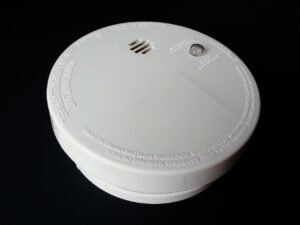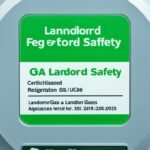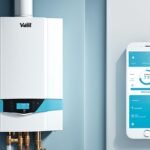As a landlord in the UK, you must ensure your tenants’ safety. Keeping up with the latest rules on smoke and carbon monoxide alarms is vital. These rules greatly affect your rental properties and what you must do as a landlord.
In July 2022, the Department for Levelling Up, Housing & Communities updated the law. The Ministry of Housing also made changes. Now, all private and social rental properties must have proper fire and carbon monoxide safety measures in England.
Key Takeaways
- The updated Smoke and Carbon Monoxide Alarm (England) Regulations apply to all private and social rental properties in England.
- Landlords are responsible for installing and maintaining both smoke and carbon monoxide alarms in their rental properties.
- Alarms must be tested at the start of each new tenancy and repaired or replaced if found to be faulty.
- Tenants have a responsibility to report any issues with the alarms and to replace batteries in battery-powered units.
- Local authorities are responsible for enforcing the regulations and can impose penalties for non-compliance.

Introduction to Smoke and Carbon Monoxide Alarms
Smoke and carbon monoxide alarms are vital for safety. They save lives during fires or gas leaks. These alarms are essential in rented homes in the UK. They warn people early, giving them time to get out safely.
Risks of Fire and Carbon Monoxide in Rental Properties
Fire and carbon monoxide dangers in rentals are serious. These alarms protect tenants from harm or even death. Fires spread fast. Carbon monoxide is invisible but can kill in big amounts.
Importance of Smoke and Carbon Monoxide Alarms
These alarms warn people early about dangers. They help tenants to act fast and leave to safety. Landlords should install and check these alarms. This keeps tenants safe and meets safety rules.
Smoke and Carbon Monoxide Detector Requirements UK Rental Properties Landlords
The Smoke and Carbon Monoxide Alarm (England) Regulations 2022 are for all rented properties in England. This rule includes homes under tenancy or licence, both by private and social housing landlords.
Properties and Tenancies Covered by Regulations
These rules apply to various rental types, including single homes and big buildings with many units. They cover all kinds of tenancies, such as assured shorthold, assured, and regulated, plus licences. Landlords must make sure their properties meet the requirements for alarms.
Exemptions from Regulations
However, there are a few exceptions. Alarms are not needed in places not for living, like garages. The rules also skip properties used for work by their tenants or for holiday lets.
Types of Smoke Alarms Required
The Smoke and Carbon Monoxide Alarm (England) Regulations 2022 don’t pick a specific smoke alarm for rental homes. They simply say that alarms must meet British Standard BS 5839-6. This gives landlords the choice to pick the best alarms for their tenants and buildings.
Battery-Powered vs Mains-Powered Smoke Alarms
Under the rules, both battery-powered and mains-powered smoke alarms are fine. Battery alarms are easy to set up. Mains alarms, on the other hand, are more reliable because they are connected to the electricity. Landlords should think about what’s best for their situation, weighing the ease of setup against the reliability.
Choosing Suitable Smoke Alarms for Tenants
Landlords should think about their tenants’ needs when adding smoke alarms. The age, how well they can move, or if they have trouble hearing or seeing all count. For instance, those that can’t hear well could find alarms with bright lights or ones that shake helpful. And tenants with sight issues might prefer alarms that talk to them or have big, easy-to-read screens.

| Smoke Alarm Type | Advantages | Disadvantages |
|---|---|---|
| Battery-Powered |
|
|
| Mains-Powered |
|
|
Types of Carbon Monoxide Alarms Required
Just like with smoke alarms, the laws in 2022 about carbon monoxide alarms leave room for choice. Landlords can pick between those that work with batteries or the ones wired into the mains. They just have to make sure they meet British Standard BS 50291.
Battery-Powered vs Mains-Powered Carbon Monoxide Alarms
There’s a choice between battery or mains-powered alarms, and both are okay. Battery alarms are easy to set up and cost less upfront. But, you need to keep changing the batteries to keep them working.
Mains-powered alarms are connected straight into your building’s power, so they can last longer without needing battery changes. Yet, they might be harder to fit without someone with the right skills.
Specialised Alarms for Disabled Tenants
If someone in the house has trouble hearing or seeing, special alarms are available. These alarms use stronger visual or vibrating signals to warn about carbon monoxide. They ensure everyone has a fair chance to escape danger.
Placement of Smoke Alarms
The Smoke and Carbon Monoxide Alarm (England) Regulations 2022 don’t give the exact spot to put smoke alarms. But, you should install them on every floor where people live. It’s best to put smoke alarms on the ceiling in places like halls or landings. These areas have good air flow.
Doing this helps spot smoke from a fire quickly. It lets people get out of the building before things get dangerous. So, putting smoke alarms in the right place can save lives.
Landlords should think about the shape and structure of a place when installing alarms. They should look at the size of rooms, how high ceilings are, and what things might catch fire easily. This way, the alarms can do their job well.
Don’t forget to test and look after smoke alarms. This makes sure they work when needed and keep everyone safe.
Placement of Carbon Monoxide Alarms
In England, the law now states where you must put carbon monoxide alarms in rental homes. These rules make sure people living there stay safe. They require alarms to be fitted in certain areas.
Fixed Combustion Appliances
These rules say you need an alarm in rooms where you sleep, if they have fixed appliances that burn fuel. But, gas cookers are an exception here. This rule covers places with things like boilers, water heaters, and open fires, which use gas, oil, or wood.
By following these rules, landlords can protect their renters. This means putting alarms in the right places stops the danger of carbon monoxide. If it spots this harmful gas, the alarm goes off, giving people a chance to get to safety.

Landlord Responsibilities
As a landlord, you must follow strict rules under the Smoke and Carbon Monoxide Alarm (England) Regulations 2022. These rules are there to keep your tenants safe. They require you to have working smoke and carbon monoxide alarms in your property.
Testing Alarms at Start of Tenancy
When a new tenant moves in, it’s your job to check the alarms. Make sure they work and have fresh batteries. This is about making your tenants feel secure in their new home.
Repairing or Replacing Faulty Alarms
If alarms break during the tenancy, you need to fix them. This could mean changing the batteries or installing new alarms. It’s important to keep the rental property safe at all times.
| Smoke Alarm Requirements | Carbon Monoxide Alarm Requirements |
|---|---|
|
|
Tenant Responsibilities
Landlords are mainly in charge of putting in and looking after smoke and carbon monoxide alarms. But as a tenant, you must help keep your place safe. You’ve got key jobs under the Smoke and Carbon Monoxide Alarm (England) Regulations 2022.
Reporting Faulty Alarms
Notice a smoke or carbon monoxide alarm not doing its job right? Tell your landlord straight away. They can then fix or change it. This keeps everyone safe at home.
Replacing Batteries in Battery-Powered Alarms
If your place uses alarms needing batteries, it’s up to you to change them when they get low. Keep an eye on the batteries. Change them so the alarms always work properly and keep you safe.
Enforcement of Regulations
Local housing authorities in England make sure the Smoke and Carbon Monoxide Alarm (England) Regulations 2022 are followed. They check that landlords do what they should and act if rules are broken.
Local Authority Enforcement
To ensure the safety of people living in rental homes, local authorities can look around. They make sure working smoke and carbon monoxide alarms are there. If a landlord doesn’t meet the rules, the authorities can tell them to fix things within a deadline by sending a letter.
Penalties for Non-Compliance
Not following the rules could hit landlords hard in the wallet. Local authorities might charge up to £5,000 for each not-working alarm. This could be a big cost if more than one alarm isn’t right. It could also cause other problems between the landlord and tenant.
Maintaining Records and Compliance
Landlords must keep detailed records to follow the Smoke and Carbon Monoxide Alarm (England) Regulations 2022. This record-keeping is key for meeting legal needs. It also gives proof if there’s an inspection or a disagreement.
How can the Landlord Prove Compliance
Start by setting up a file or digital folder. This should track all your steps to comply. In it, store copies of when alarms were installed, tested, and any fixes or replacements.
It’s also wise to get tenants to confirm they know about the alarms and they work. This could be a signed note when they move in or during their stay.
Keeping these records ensures you can prove you’ve done your part under the Smoke and Carbon Monoxide Alarm (England) Regulations 2022. Good documentation helps you steer clear of fines. It also makes sure your tenants are safe.




